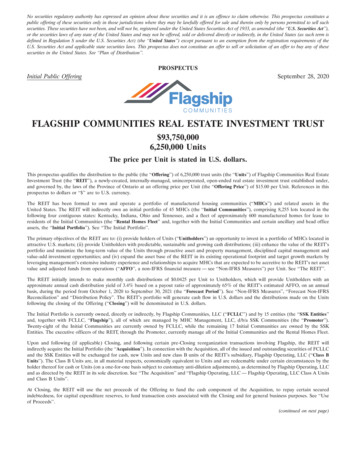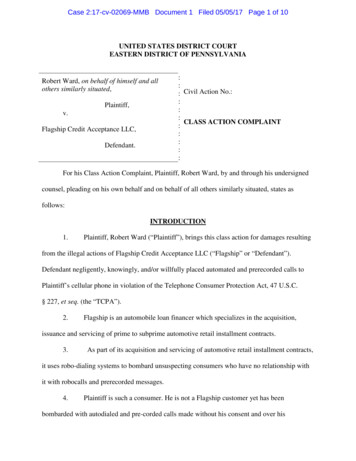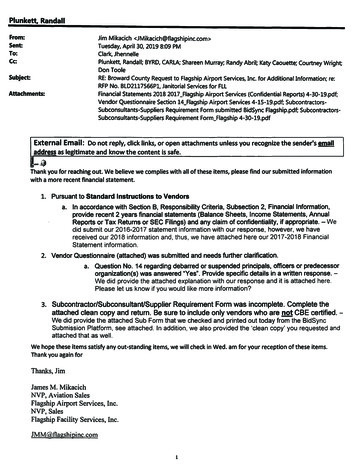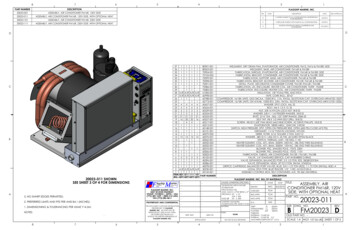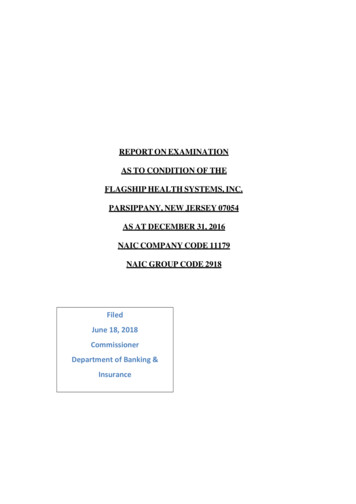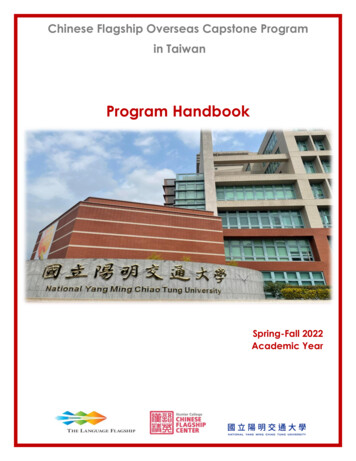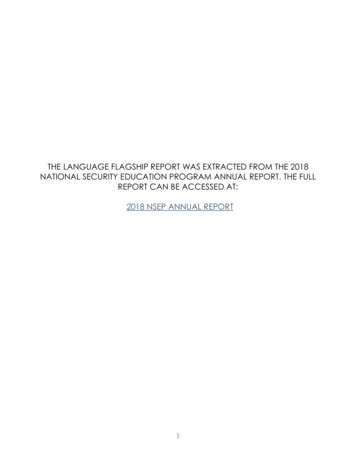
Transcription
THE LANGUAGE FLAGSHIP REPORT WAS EXTRACTED FROM THE 2018NATIONAL SECURITY EDUCATION PROGRAM ANNUAL REPORT. THE FULLREPORT CAN BE ACCESSED AT:2018 NSEP ANNUAL REPORT1
THE LANGUAGE FLAGSHIP: OVERVIEWproficiency testing, cultural learning, meaningfultechnology use, advanced level teaching andteacher preparation, and enhance opportunitiesfor students to fulfill federal government service.The Language Flagship is authorized under theDavid L. Boren National Security Education Act(NSEA), as amended, P.L. 102-183 as a nationaleffort to change the way Americans learnlanguages.Flagship programs, created asinnovative partnerships between the federalgovernment and the academic community, aimto systematically produce a pool of languageproficient professionals with linguistic and culturalexpertise critically needed for U.S. national andeconomic security.For academic year 2017-2018, The LanguageFlagship sent 413 students overseas for immersivelanguage and culture learning.2017-2018 FLAGSHIP OVERSEASENROLLMENTThe Language Flagship core program is comprisedof grants to U.S. Institutions of Higher Education(IHEs) to support domestic Flagship programs andOverseas Flagship Centers. Domestic FlagshipPrograms develop articulated language learningpathways to guide students from all majors andlanguage backgrounds through formal instructionand guided interventions towards advanced-levellanguage proficiency. Overseas Flagship Centersprovide directed language instruction, nship experiences that foster the attainmentof professional-level language proficiency duringan overseas Capstone year experience.49149215In addition to the core program, The LanguageFlagship sponsors the following initiatives throughcompetitive grants to IHEs to promote andimprove U.S. students’ language learning andcultural expertise: Regional Flagship Languages Initiative(RFLI); K-12 / Higher Ed Partnership Initiatives; Proficiency Initiative; Flagship Culture Initiative; Flagship Video Project; Flagship Technology Innovation Center;and State Language Roadmaps.Flagship CapstoneFlagship SummerRFLIFlagship currently has 107 2018-2019 Flagshipstudents participating in the Overseas Capstone.An additional 21 Chinese and Portugueselanguage students will begin their Capstoneexperience in spring 2019.These additional initiatives and programs allowFlagship to develop language resources;strengthen the K-12 language pipeline; and makekey investments that foster the adoption of2
THE LANGUAGE FLAGSHIP: CORE PROGRAMThe Language Flagship currently sponsors 31programs at 21 universities in Arabic, Chinese,Korean, Persian, Portuguese, Russian, and Turkish.Together, the Flagship programs strive to graduatestudents from an array of majors with an exitproficiency of Interagency Language Roundtable(ILR) Level 3 in one of The Language Flagship'starget languages. 1Overseas Capstone Flagship Centers providestudents continued, directed language instructionthat articulates from their domestic Flagshiplearning. While overseas, Flagship students enrollin coursework that supports their academic majorand participate in a professional internshipexperience.Flagship universities have enhanced theirlanguage offerings and curriculum creating moreintensive language programs that start at thebeginner level and build to the ILR 3 level. AllFlagship programs provide: Weekly group and individualized tutoring; Integrated content-based instruction andcourses across disciplines; Outcomes-based,studentlanguage instruction; Immersive learning environments, such asliving-learning environments; Guided cultural functionscurricular activities; and The expectation of student success,including the goal of professional-levelproficiency and Flagship Certification.centeredand2018 Chinese Flagship student during her overseasCapstone year in Nanjing, ChinaAll overseas instruction is conducted in the es to use their target language inacademic, professional, and social environments.In addition, most students undertake nts, which fosters an immersiveenvironment, further develops their languageproficiency, and provides opportunities for deeperunderstanding of the host country people andculture.co-Flagship students are undergraduates from anarray of majors and language backgrounds whoself-select to take on the challenge of a Flagshipexperience.Students pledge their time tocompletealldomesticandoverseasrequirements. These requirements include takingboth language classes and content coursestaught in the target language, attending out-ofclassroom group practice and individualizedtutoring sessions, and participating in frequentdiagnostic and proficiency assessments. Theseinterventions are necessary to reach the goal ofbecoming professionally-proficient in one ofFlagship’s target languages.The Persian Language Flagship Program uses ayear-long domestic Capstone immersion hostedat the University of Maryland. The domesticimmersion program integrates intensive languageinstruction, a language pledge, a self-containedon-campus living space, and opportunities forinternships using Persian language. The programresults have proved that a domestic immersion ispossible for languages and areas where overseasstudy is not feasible.1 See Appendix J for Interagency Language Roundtable. Retrieved from http://www.govtilr.org/skills/ILRscale2.htm. December 4,2018.3
2018 PROGRAM ENROLLMENTS2018 OVERSEAS ENROLLMENTSFor fall 2018, there are 1,104 FlagshipUndergraduates participating in The LanguageFlagship programs.Flagship students who demonstrate advancedlevel skills (ILR Level 2 or above) in speaking and aminimum of ILR 2 in reading or listening (with nolower than ILR 1 in any modality) are eligible toparticipate in a year abroad at an OverseasFlagship Center.For fall 2018, 107 studentsparticipated in one of the Flagship OverseasCapstone programs; an additional 21 Chineseand Portuguese language students will begin theirCapstone experience in spring 2019.2014-2018 FLAGSHIPUNDERGRADUATE 100-9901,0411,0691,0601,104In the domestic pipeline, the number of studentspreparing to study at one of the Overseas FlagshipCenters for the 2019-2020 academic year isincreasing. For the 2018-2019 academic year, TheLanguage Flagship has 128 students undertakingstudy and work experiences through OverseasFlagship 014-2018 OVERSEASFLAGSHIP CAPSTONE ENROLLMENTSFall18150At the Domestic Flagship Centers, an additional2,415 At-Large students participated in Flagshipcourses and activities. At-large students are thekey to Flagship program recruitment. Flagshipprograms provide the same level of rigor andaccess to high-level language instruction to allstudents who choose to participate in Flagshipcoursework. This approach improves the whole ofthe university language instruction in Flagshiplanguages. Flagship mid-year enrollment for the2018-2019 academic year is 3,519 Final17-18Fall18FLAGSHIP FEDERAL SERVICE INITIATIVES3,5003,0002,500The Language Flagship engages studentsinterested in government service. Boren FlagshipScholarships and ROTC Flagship ensure thatFlagship students use their acquired language skillsin the service of the government or the 61,000500128754,0001,5001351002014-2018 DOMESTICFLAGSHIP PROGRAM ENROLLMENTS2,000125149In addition, the Regional Flagship LanguagesInitiative (see RLFI section) provides expandedlanguage and culture training for Boren Scholarsand Fellows studying in Africa (Ghana,Mozambique, Senegal, South Africa, andTanzania), India, and Indonesia.-Flagship UndergraduatesAt-Large4
In 2018, the Flagship programs sponsored 109students with service commitments (BorenFlagship; contracted ROTC Flagship; RegionalFlagship Languages Initiative awardees).Inaddition, NSEP collaborates with federal agenciesto coordinate internship opportunities and otherprofessional opportunities for Flagship students aspathways into federal service.Boren advising and outreach opportunities atFlagship programs further increases the pool ofFlagship certified students prepared to addressthe current and future needs of the federalgovernment for language and culture expertise.Since 2011, there have been 154 Boren FlagshipScholars who have successfully completed thedomestic and overseas Flagship program.BOREN FLAGSHIP SCHOLARSROTC FLAGSHIPIn April 2018, NSEP awarded 30 new Boren FlagshipScholarships for study at Flagship OverseasCapstone Centers for the 2018-2019 academicyear.The Language Flagship, in coordination with theProject GO program launched the ROTC Flagshipinitiative in 2012. The goal of the ROTC Flagshipinitiative is to significantly increase the number offuture military officers who commission withprofessional-level language proficiency. This effortreduces the burden on the Services for costlytraining and retraining of mid-career officers forkey positions requiring foreign language andregional expertise.The ROTC Flagship initiative includes domesticscholarship support provided by the Army CadetCommand and Air Force Education and TrainingCommand. Both the Army and Air Force ROTChave created opportunities to provide ROTCscholarship support to qualified Flagship studentsat any of the existing Flagship institutions.The Air Force Language Flagship scholarshipspermit students the opportunity for a fifth year ofstudy overseas funded by The Language Flagship.These scholarship arrangements provide fullsupport for future officers to gain professionallanguage proficiency and significant regionalexperience prior to commissioning.Uponcommissioning in the Air Force, ROTC Flagshipgraduates may enroll in the Language EnabledAirman Program (LEAP), in order to maintain theirlanguage skills.The Army also providesscholarships to students enrolled in one of TheLanguage Flagship institutions and has agreed tolet Army ROTC students study abroad for a fifthyear.Arabic Flagship student visits Chefchaouen, a city inNorthwest Morocco, during her 2018 overseas CapstoneFlagship also supports one Senior Military College,the University of North Georgia (UNG), which has aChinese ROTC Flagship program. There are 42ROTC cadets enrolled in UNG's Chinese Flagshipprogram for academic year 2018-2019.Boren Flagship Scholars meet Flagship’s goals ofprofessional-level language proficiency andpreparing high-quality candidates for federalservice.The Flagship program continues toimprove recruitment of Flagship students whoapply for and then receive Boren Scholarships.ROTC Flagship initiative efforts empower andencourage all Flagship programs to collaboratewith their ROTC detachments. Cooperatively,5
they develop pathways for cadet recruitment,Flagship participation, and success throughcompletion of a Flagship Capstone program.2018 PRE- AND POST-CAPSTONE ACTFLSPEAKING PROFICIENCY (N-105)250For academic year 2018-2019, there are 64 ROTCcadets and midshipmen enrolled in The LanguageFlagship in Arabic, Chinese, Korean, Persian,Russian, and Turkish programs.This numberincludes seven ROTC cadets who are currentlyparticipating in Capstone programs in Arabic,Chinese, Russian, and Turkish. The current ROTCFlagship breakdown by service is as follows: Army- 47; Air Force - 16; and Navy - 1.4548353530252015161052018 PROFICIENCY RESULTS0The 2018 Flagship proficiency outcomes includethe Arabic, Chinese (Beijing and Nanjing), HindiUrdu, Korean, Persian, Russian, and Turkish results.The data for the Chinese Spring Nanjing andPortugueseproficiencyoutcomeswereunavailable at the time this report was submitted.105 Flagship undergraduates were tested usingpost-Capstone OPI, and of these, 77%demonstrated ILR Level 3 (professional-level)proficiency in speaking, and 96% achieved ILR 2 or higher.1 05 1ILIMIHAL114AMAHSSpeaking Post-Of the returned Capstone students, 105 studentscompleted assessments through the FlagshipAssessment battery in reading and listeningadministered through American Councils forInternational Education.Ninety-two percent of Flagship students whocompleted the Flagship Reading Assessmentscored in the ILR 2 range or higher, and 38%scored in the ILR 3 range or higher. For the FlagshipListening Assessment 86% scored in the ILR 2 range or higher, and 44% scored in the ILR 3 rangeor higher.96.2%2018 PRE- AND POST-CAPSTONE ILRREADING PROFICIENCY (N-105)77.1%70605950ILR 1 3.8%19.0%ILR 2ILR 2 564030ILR 3 ILR 2 andandAbove Above101801 06292Reading Pre-110 students pre-tested. 105 completed post-tests.313020In 2018, Capstone assessments were also ratedusing the ACTFL scale.Of the 105 scoredassessments, 46 students demonstrated ACTFLSuperior Proficiency and 45 demonstratedAdvanced-High proficiency in speaking.21 02Speaking Pre-2018 POST-CAPSTONE ILR SPEAKINGPROFICIENCY OUTCOMES (N-105)100%90%80%70%60%50%40%30%20%10%0%4645402 903Reading Post-3
2018 PRE- AND POST-CAPSTONE ILRLISTENING PROFICIENCY (N-105)32018 BOREN FLAGSHIP SCHOLARFSI EXIT PROFICIENCY (N-22)1614605053403044108343220101411 2Listening Pre-22 0342120245 50 2SpeakingListening Post-Reading2017 BOREN FLAGSHIP SCHOLARDLPT EXIT PROFICIENCY (N-22)10986BOREN FLAGSHIP SCHOLAR ASSESSMENT88864In 2018, NSEP continued working through theForeign Service Institute (FSI) to test Boren FlagshipScholars upon completion of their OverseasFlagship Center program.The assessmentsconducted by FSI assessed the students’ speakingand reading proficiency.320101101 ReadingOf the 22 Boren Flagship students who completeda 2018 capstone program, all were assessed byFSI. Fifteen (68%) received an ILR Level 3 or higheron their FSI speaking assessment and 12 (55%)received an ILR Level 3 or higher on their FSIreading assessment.22 3ListeningTwenty-two Boren Flagship Scholars also took theDefense Language Proficiency Test (DLPT) listeningand reading assessments.4 Of the students tested,8 (36%) scored an ILR 3 in listening and 8 (36%)scored an ILR 3 in reading, while 17 (77%) scoredan ILR 2 or higher in listening, and 16 (73 %) scoredan ILR 2 or higher in ed an ILR Level 2 or higher on their FSIspeaking assessment and 17 (77%) received an ILRlevel 2 or higher on their FSI reading assessment.40 13 The assessment outcomes show that 22% of the2017-2018FlagshipCapstonegroupdemonstrated 3/3/3 or ILR 3 proficiency in themodalities of speaking, listening, and readingupon completion of their overseas year. Theresults for 3/2 /2 , which is the requirement forFlagship Certification, revealed that 64% of thecohort demonstrated this exit proficiency.31062201512109 students pre-tested. 105 completed post-tests.Boren Flagship Scholars only take the lower level DLPT. The lower level DLPT tests from 0-3 on the ILR scale.7
Flagship students who get certified as FlagshipGlobal Professionals complete domestic andoverseas Flagship program components, directenrollment coursework through a host-countryinstitution, in-country internships, and demonstratethe proficiency standard of ILR 3 speakingproficiency, and 2 in both reading and listening.In addition, 228 students completed Flagshipdemonstrating ILR 3 proficiency in speaking,reading and listening (ILR 3/3/3).Flagship Culture Initiative — The Flagship CultureInitiative is an effort to develop open-source onlineculture curricula across Arabic, Chinese, andRussian programs and general cultural awarenessmaterials for all Flagship language programs. Thematerials developed will be used for the culturalpreparation of students preparing for andparticipating in the Flagship Overseas Summerand Capstone programs.Flagship Video Project — The Language FlagshipVideo Project is an effort to assess the professionalcapabilities of post-Capstone Flagship students intheir target language. The methodology andprocess being developed through the project willprovide an additional way to demonstrate anddocument Flagship students’ capabilities in theirtarget language beyond the required proficiencytesting.Indiana University Arabic Flagship students in theMoroccan desert during their 2018 overseas Capstone2018 FLAGSHIP PROGRAM INITIATIVESNew Flagship Awardees — The Language Flagshipheld an open national competition for newDomestic Flagship Centers in four languages. Thecompetition results were announced with the startof the new awards on August 1, 2018. The newFlagship programs selected were Brigham YoungUniversity and University of Mississippi for Arabic,University of Wisconsin-Madison for Korean,University of Texas-Austin for Portuguese, andIndiana University and University of Georgia forRussian. The Language Flagship now supports 31Domestic Flagship Programs across 21 institutionsof higher education and eight Flagship CapstoneCenters, seven overseas and one domestic.During 2018, The Language Flagship Video Projectwas able to film videos of all Arabic, Chinese, andRussian Capstone participants at the end of theiroverseas Capstone programs presenting to anaudience on various social, economic, scientific,and business topics as well as responding toquestions from the audience in their targetlanguage. The Language Flagship Video Projectalso convened experts to develop a codingschema to analyze the professional capabilitiesthe students demonstrated in the videos.New Overseas Program — The Language Flagshipannounced a competition to add a new FlagshipOverseas Capstone Center in Taiwan. The resultsof the competition will be determined in January2019 with the first planned cohort of students toattend in fall 2019.2020 Flagship Competition — In spring 2019, TheLanguage Flagship will conduct a full and opencompetition for all domestic undergraduateFlagship programs. The anticipated submissiondeadline is September 2019 for new four-yearawards to begin on June 1, 2020 for the 2020-2024grant cycle.Flagship Certification — The Language Flagshipcertified their 500th undergraduate Flagshipstudent in May 2018, and now stands at 527Flagship Certified graduates. Flagship remains theonly outcomes-based academic program withthe goal of professional-level proficiency acrossseveral critical languages.Undergraduate8
2018 LANGUAGE FLAGSHIP INSTITUTIONSKOREANUniversity of HawaiiUniversity of Wisconsin, MadisonKorea University, South KoreaARABICBrigham Young UniversityIndiana UniversityUniversity of ArizonaUniversity of MarylandUniversity of MississippiUniversity of OklahomaUniversity of Texas-AustinArab-American Language Institute in Morocco*Moulay Ismail University, Morocco*PERSIANUniversity of MarylandPORTUGUESEUniversity of GeorgiaUniversity of TexasFederal University of São João del-Rei, BrazilCHINESEArizona State UniversityBrigham Young UniversityHunter CollegeIndiana UniversitySan Francisco State UniversityUniversity of HawaiiUniversity of MinnesotaUniversity of MississippiUniversity of North Georgia**University of OregonUniversity of Rhode IslandWestern Kentucky UniversityBeijing Union University*China Nanjing University, China***RUSSIANBryn Mawr CollegeIndiana UniversityPortland State UniversityUniversity of California, Los AngelesUniversity of GeorgiaUniversity of Wisconsin, MadisonAl-Farabi Kazakh National University, Kazakhstan*TURKISHIndiana UniversityAzerbaijan University of Languages, Azerbaijan *Overseas Flagship Centers are in Italics*Overseas Flagship Center managed byAmerican Councils for International Education**ROTC Flagship Program*** Overseas Flagship Center managed jointly byBrigham Young University and AmericanCouncils for International EducationAFRICAN FLAGSHIP LANGUAGES INITIATIVEUniversity of FloridaThe West African Research Center, Senegal*Universidade Eduardo Mondlane,Mozambique*MS-Training Center for DevelopmentCooperation, Tanzania*SOUTH ASIAN FLAGSHIP LANGUAGES INITIATIVEUniversity of Wisconsin, MadisonAmerican Institute of Indian Studies, India*INDONESIAN FLAGSHIP LANGUAGES INITIATIVEUniversity of Wisconsin, MadisonState University of Malang, Indonesia*9
THE LANGUAGE FLAGSHIP: REGIONAL FLAGSHIPLANGUAGES INITIATIVEThe Regional Flagship Languages Initiative (RFLI) isa joint initiative between the Boren Scholarshipsand Fellowships program and The LanguageFlagship designed to improve languageproficiency outcomes in targeted languages. TheIntelligence Authorization Act for Fiscal Year 2010,Section 314 (P.L. 111-254) directed establishmentof a pilot program in order to build languagecapabilities in areas critical to U.S. national securityinterests, but where insufficient instructionalinfrastructure currently exists domestically. NSEPwas designated to spearhead the effort. The RFLIprogram draws on the best practices developedby The Language Flagship.implementing domestic and overseas programs inthese languages.All award recipients of RFLI are funded through aBoren Scholarship or Boren Fellowship. Participantscomplete eight weeks of domestic, summerlanguage study, followed by an intensive,semester-long overseas study program. Manyawardees continue overseas study during theirspringsemester,conductingindependentresearch or participating in internships. Throughthe RFLI model, NSEP equips and empowersAmerican students to achieve measureableproficiency gains in their chosen language, as wellas gain deep cultural and regional knowledge. Aswith all Boren Scholars and Fellows, these awardrecipients commit to working one year for thefederal government after graduation.2018 IFLI participant at a farm in Batu, Malang learninghow to tilt and soil a “sawi” plant2018 RFLI HIGHLIGHTSIn 2018, there were 83 undergraduate applicantsfor RFLI Boren Scholarships programs: 51 applicantsfor the AFLI Boren Scholarship, 19 applicants for theSAFLI Boren Scholarship, and 13 applicants for theIFLI Boren Scholarship.NSEP awarded 31 AFLI Boren Scholarships, 11 SAFLIBoren Scholarships, and seven IFLI BorenScholarships for the 2018-2019 summer andacademic year.Currently there are three RFLIs: African FlagshipLanguages Initiative (AFLI), which includeslanguage study in Akan/Twi, French (for Senegal),Portuguese (for Mozambique), Swahili, Wolof, andZulu; South Asian Flagship Languages Initiative(SAFLI), which includes language study in Hindiand Urdu; and Indonesian Flagship LanguageInitiative (IFLI), which includes language study 49There were 52 total applicants for the RFLI BorenFellows program. The applicants by language areas follows: 23 applicants for the AFLI BorenFellowship, 16 applicants for the SAFLI BorenFellowship, and 13 applicants for the IFLI BorenFellowship.The selection of languages under RFLI are basedon four primary criteria: critical need to U.S.national security; critical need to improve ateandadvancedinstructionalmaterials; and basic infrastructure in existing orpotential overseas programs. In addition, NSEPconsiders the feasibility of designing andNSEP awarded 12 AFLI Boren Fellows, six SAFLIBoren Fellows, and four IFLI Boren Fellows in officialdomestic and/or overseas RFLI programs.10
LIFellows13Total52Recipients126422DOMESTIC PROGRAMThe University of Florida designed andimplemented an AFLI program for the study ofAkan/Twi, French, Swahili, Wolof, and Zulu duringsummer 2018 and the University of Wisconsin,Madison designed and implemented the SAFLIand IFLI program for the study of Hindi, Urdu andIndonesian. Overall, all 71 Boren/RFLI Scholars andFellows participated in this language BorenFellows0263133422Total211111811161171OVERSEAS PROGRAMSRFLI overseas immersion programs provide BorenScholars and Fellows with in-country, directedinstruction and additional resources to furtherimprove language proficiency.Throughcollaboration with domestic RFLI programs, theAmerican Councils for International Education,and overseas partners, RFLI currently sponsors sixoverseas programs: French through the West African ResearchCenter in Dakar, Senegal; Portuguese through the UniversidadeEduardoMondlaneinMaputo,Mozambique; Swahili through the MS Training Centre forDevelopment Cooperation in Arusha,Tanzania; Hindi through American Institute for IndianStudies (AIIS) in Jaipur, India; Urdu through AIIS in Lucknow, India; and Indonesian through the State University ofMalang in Malang, Indonesia.Each overseas program collaborates with NSEP tomake the most of each location’s offerings. Allprograms continue use of the communicativeapproach and task-based language learning.Classroom instruction is supplemented byindividual and group conversation practice, selfmanaged learner development, and homestayexperiences.RFLI summer domestic programs run for eightweeks and focus on proficiency-based instruction.Teaching is conducted by expert, native-speakinginstructors. Classes meet four hours a day, fivedays a week, and each week includes three - fivehours of mandatory conversation practice and/ortutoring sessions. All instruction is task-based; thus,students are asked to do meaningful tasks usingthe target language.In total, 47 Boren Scholars and 21 Boren Fellowsstudied at official RFLI overseas programs in 2018.In addition, two AFLI-funded Boren recipientsstudied Akan/Twi in Ghana and one studied Zuluin South Africa at self-identified programs.RFLI/Boren Scholars and Fellows also engage inactivities designed to improve their languageacquisition such as interacting with nativespeaking host families and/or living in a ing in cultural events and excursions.2018 RFLI BOREN AWARDEESCountryMozambiqueGhanaSenegalSouth AfricaTanzaniaIndiaIndonesiaTOTALOver the course of the summer, students earnacademic credit equivalent to one year ofinstruction. The program is open to students fromall majors and is designed to allow participants toachieve functional language proficiency inmultiple skills (reading, writing, speaking, andlistening) to ensure adequate preparation for RFLIoverseas 136422Total11211118171171
Boren Scholars and Fellows demonstratingIntermediate proficiency or above. All programparticipants deepened cultural and regionalknowledge through their immersive overseasstudy.RESULTSRFLI demonstrated impressive proficiency gains forthe 38 Boren Scholars and Boren Fellows who weretested before and after their RFLI-supportedprograms (summer and overseas) and the 40Boren Scholars and Boren Fellows that were testedbefore and after their overseas program in 2017.Testing was conducted through Oral ProficiencyInterviews, which rate speaking proficiency usinga common rubric developed by the InteragencyLanguage Roundtable (ILR).2017 RFLI PRE- AND POST- SPEAKINGPROFICIENCY GAINS (N-40)25202018 SAFLI Urdu students during their extracurriculartabla class151050NoPrior0 1Pre-RFLI1 22 3Post-RFLIFollowing post-RFLI assessments, 29 (73%) studentsdemonstrated Advanced proficiency (ILR 2 orhigher), with three (seven percent) achieving aSuperior level (ILR 3 or higher) of proficiency.Another 11 (27%) students demonstratedIntermediate-level proficiency, with 100% of RFLI12
THE LANGUAGE FLAGSHIP: K-12 PROGRAMSDLNSEO’s kindergarten through grade 12 (K-12)initiatives seek to address the scarcity of U.S.citizens graduating high school with proficiency incritical languages and in-depth knowledge ofother cultures and regions. There is a growing poolof such students poised for recruitment intoLanguage Flagship programs. Once admitted,these students are positioned to make steadyprogress towards ILR Level 3 proficiency (generalprofessional proficiency). Proven models of highquality, results-oriented programs serve to improveteaching and learning and expand K-12 learningopportunities to address national security andeconomic needs. Current investments include aK-16 articulated program and linkages projectsfocusedonaligningsecondaryandpostsecondary programs.Luther King (MLK) Elementary, and a thirdelementary program began at Harrison Park (HP)in fall 2017 in a Cantonese neighborhood with agoal of Mandarin and English literacy.A Hunter Global Linkage student (left) and a Flagshipstudent (right) paired up at a supermarket in Flushing,Queens to learn the Chinese names of produceDuring 2017-2018, The Language Flagship’s highereducation partnerships with K-12 and communitycollege educators impacted 3,500 students, 131teachers or instructors, and 14 curriculumspecialists or administrators in six states.Inaddition, website analytics attest to curriculumresources and online professional developmentimproving and expanding programs throughcurrent and past K-12 Language Flagship projects.There were 90,413 unique visitors involved inRussian, Chinese, and Portuguese teaching whoviewed a total 370,422 pages of content for DualLanguage Immersion (DLI) and secondary-startprograms.Based on a recent ethnographic study, a selfevaluation, and an external review (2017),recommendations emerged to guide energiesand resources. For 2017-2018, the project focuseson secondary efforts that involve honing robust,proficiency-aligned, multiple pathways and te Chinese Flagship programs andincrease the number of high school graduatesmeeting the academic and language proficiencytargets of university Chinese Flagships.During the 2017-2018 academic year, there were792 K-12 students in the MIP. Secondary MandarinWorld Language and Native Speaker Literacycourses impacted 480 grade 6-12 students. PPShas a staff of 15 teachers and four curriculumspecialists actively engaged in the MIP who aredirectly impacted by the K-16 Chinese LanguageFlagship project and an additional 19 Chine
Flagship sent 413 students overseas for immersive language and culture learning. 2017-2018 FLAGSHIP OVERSEAS ENROLLMENT Flagship currently has 107 2018-2019 Flagship students participating in the Overseas Capstone. An additional 21 Chinese and Portuguese language students will begin their Capstone experience in spring 2019. 149 215 49



